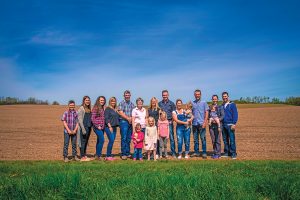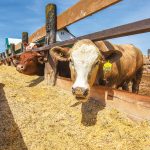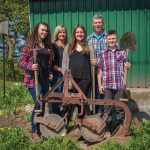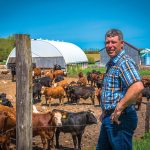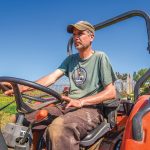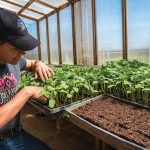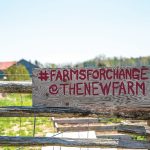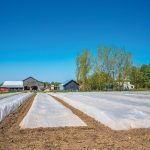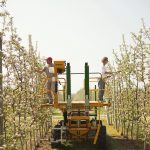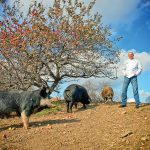The changing face of farming in Southern Georgian Bay
by Emily Worts
photography by Doug Burlock
Agriculture is one of the primary industries that helped establish and shape the area we now refer to as Southern Georgian Bay, and today it remains one of the area’s largest economic drivers. Our landscape, with its rolling hills, proximity to Georgian Bay and its unique placement on the Niagara Escarpment, is attracting more and more people to the area, all with different needs and ideas on how to enjoy and live in harmony amidst this rural backdrop. Shifting demands, evolving markets and new technology have all contributed to the changing face of farming in Southern Georgian Bay. However, despite the growth and changes, agriculture continues to play a vital role in our community and will continue to shape our identity – and our economy – for generations to come.
The small farming town of Creemore was shocked when Paul Millsap, aged 74, passed away unexpectedly after putting in an eight-hour day haying his fields. Many friends his age were well-settled into retirement but for Millsap, retirement wasn’t in the forecast. “The retirement age of farmers is when they die,” says John Millsap, Paul’s 44-year-old son. “Farming isn’t a job, it’s a lifestyle, and you don’t retire from that.”
According to Statistics Canada, the average age of Canadian farmers is getting higher and higher and now rests at 55. It is an aging demographic with fewer of John’s generation stepping up to replace their elders. But when his father passed away, John left his full-time carpentry job to run the farm, and he hasn’t looked back.
“It can be a challenge; I put in some long days,” he says of working 15 hours a day, seven days a week. “But if I don’t like it, I suck it up. I can’t take it away from the next generation; it’s a family farm.”
John is a fifth-generation farmer whose family has been farming on top of Mount Zion, the hill that stretches skyward south out of Creemore, since the mid-1800s. His ancestors fled the Irish famine for Canada, with the promise of arable land and a future.
“We still have the blanket box they brought over,” he says of his forebears who made the long and harrowing journey across the Atlantic. “Their whole life was in that box. It was all they were allowed to bring.”
John’s great-grandfather was one of the 11 children who made that voyage. Upon arriving, the family was sent to the hills above Creemore. Today there are three Millsap farms on the hill, with 600 acres in total. Mount Zion can be a foreboding and solitary place, but for cattle farming it’s pretty close to perfection, says John.
“The area is perfect for cattle as the cows prefer the colder temperatures that come with the elevation.”
The land, and the water it holds, are ideal for growing corn, barley, wheat and hay, which all go into feeding the Millsap herd of Charolais and Angus cattle.
Millsap still uses the original bank barns and infrastructure his ancestors built in the 1800s and the farm is very much a family affair. John’s mother, Gayle, a retired school teacher, still lives in the home farm; at 66, she keeps a few cattle and runs her own small farm operation. John works the remaining patch with his cousin Dave, whose 19-year-old son, Tate, also works full-time on the farm. His uncle Dennis, 79, a mechanic, still comes to the farm every day to check on the machinery, and John’s own children, Grace, Libby and Luke, help with the hay and are learning all about running the farm on a daily basis.
“We’re all still here,” says John of the generations of Millsap aunts, uncles and cousins. Having so much family around is mandatory in running their family farm, he adds; it couldn’t be done without extra hands who know the business and have a personal connection to the land.
“You need someone who knows cattle and knows tractors. It works well with all the family,” says Millsap, “I don’t know what you’d do without family.” The Millsaps are fortunate: all of their extended family, save for one cousin, still live in the area, so help is always a phone call away. But for many farms, the family has moved on to jobs in the city, where the work isn’t as isolated, as backbreaking or as all-consuming. (How do you even go away for the weekend if there are cows that need to be fed?)
“There was a generation that didn’t want to do the work,” says Shauna Millsap, John’s wife, noting that across Ontario there has been a steady decline in farmers aged 35 to 54. “But I think that is changing with this new generation,” she adds optimistically.
That gap has left its mark, however, and John fears the family farm is becoming extinct. “The family farm is dying,” he laments. “We’re having smaller families and the cost of land is driving farmers out. With the high prices of land, it’s pretty enticing to sell. We’re going the way of the dodo bird.”
However, he adds firmly, transitioning out of farming and handing the land over to other interests isn’t an option for his family. “I’d like to see the land farmed by somebody in the family,” he says, and while he acknowledges it may not be one of his own children, he hopes it will be a relative of some sort. “The land was given to us by the government; why would we give it away?”
As far as a succession plan, to-date the Millsaps have relied on luck; every generation has produced someone who was willing to take over the farm. And the Millsaps are not alone in leaving the future to chance; only eight per cent of farmers in Ontario have a written succession plan, making the future of family farms fragile at best.
“If we’re lucky maybe we can get Luke over there,” John says wistfully, pointing in the direction of the original family farm where his mother still lives and which he hopes his son, who shows some interest in farming, might take over one day. Luke is slowly learning how to look after the animals and use the machinery. But Luke is only 12 – a lot can happen between now and maturity.
The alternative – watching his children leave the family farm – is unthinkable. It’s also usually permanent; those who leave farming usually leave for good, says John.
“Once you get out of farming it’s hard to get back,” he says. “You have to grow up with it to understand it. If I wasn’t a generational farmer I wouldn’t buy into millions of dollars of capital.” As younger potential farmers leave their family farms, the land is often sold off and absorbed by other farms or transitioned to other uses including development, weekend retreats or industrial interests such as quarries.
Like other industries, farming is subject to fads and trends, but unlike other businesses, the huge investments required to run a successful farm cannot be traded in on a whim.
“You don’t go in and out of beef farming. The investments are too great,” says John. “If you’re in, you’re in.”
For now at least, the Millsaps are all-in. Though the Millsap clan is committed to holding onto their family farm and heritage, theirs is one of only four family farms left in the area. “Between Ruskview, Lavender and Mount Zion there were 30 family farms,” says Millsap. “We are down to four and there goes the community.”
More and more, this “community” farmers once relied upon for survival is being absorbed by larger, “commodity” operations. “The problem is there are too many big farms,” John maintains. “There is no neighbour support. When everyone had 100 acres, everyone got together, at church, at school. There was support. Our neighbours are good, but in a lot of places one farmer buys up all the land. Who are you going to ask for help?”
According to StatsCan, the number of Canadian farms has been declining steadily since 1941, along with the number of farm operators, while the size of farms is increasing. Between 2011 and 2016 (the last year statistics were taken), the size of the average Canadian farm grew from 728 acres to 778 acres.
“If you don’t feel like you’re part of a community, it comes down to why are we doing it? It’s not fun,” says John. Then he quickly adds, “Farming is still fun for me.”
Helping to bring that culture of community back to farming is part of Philly Markowitz’s job description as Grey County’s economic development officer for local food. Farmers and all the businesses that go into growing and preparing food help keep our communities viable, she says.
“When we have farms amalgamating, we lose the small rural communities and we don’t want to lose small rural communities,” explains Markowitz. “It’s an uphill battle, not just here but across the world. We’re seeing increased land price pressure, encouraging commodity farmers to get larger and larger.” Her mantra: “encourage, attract and support.” With this in mind, she works in partnership with other municipalities, including Bruce and Simcoe, to attract, promote and market local players involved in the local food system.
Another big piece of the puzzle for Markowitz, and one that is often missing, is education, so she has partnered actively with Georgian College and the Small Business Enterprise Centre to create a specialized curriculum for our area that focuses on agriculture. She has also launched independent continuing education projects and has implemented a number of events and workshops. The workshops and conferences are diverse and cover everything from agricultural technology to food regulatory systems.
A recent workshop attracted small farmers and processors who wanted to diversify by adding another stream onto their business. “The workshop helped them find out more before they got into spending their money.”
With the help of people like Markowitz, our unique landscape is attracting new, young, innovative farmers, and the area is seeing a resurgence in small-scale agriculture. From 2011 to 2016 in Grey County alone, 56 new farms were added to the landscape, many of these operated by young farmers, each bringing new ideas and products to our local food system. The most significant increases were on each end of the size spectrum: micro farms (farms between 10 and 69 acres) and massive farms over 2,200 acres. Specialty farmers working on smaller plots of land are growing and innovating a diverse array of products, often adding value to their products on-site.
“Large farms are getting larger and small farms are getting smaller,” notes Markowitz. “This is where we are seeing some interesting opportunities.”
Just up the road from the Millsap farm is the New Farm, a certified organic family farm growing premium quality vegetables for restaurants and retailers across Southern Ontario. When Gillian Flies and Brent Preston first bought their farm just outside of Dunedin, they were surrounded by farmers, many of whom had a different vision than theirs, but who nonetheless shared a connection to the land and had devoted their lives to farming it. Conversations with their neighbours helped the two young farmers see the potential in the area for a new type of farming model. Today those conversations are few and far between.
“None of our neighbours farm anymore,” says Flies. “They’re all pretty much out of it. They rent their land to bigger operations.”
She adds the land around them, which is primarily agricultural, no longer belongs to family farms. It has been absorbed by massive commodity farming operations that have become faceless in an age of increasingly mechanized farming practices.
“The closest person to me who is an active farmer is three to four kilometres away.”
Like John Millsap, Flies, who grew up on an organic farm in Vermont, sees farming as a lifestyle, a culture and a tradition. The problem is, it is a lifestyle that is inaccessible to many, with the biggest barrier being the cost of land. The demand for property in Ontario is increasing its value and changing our rural landscape. StatsCan numbers show the average value of land and buildings on Ontario farms increased 41 per cent between 2011 and 2016, to $9,580 per acre. The national value is $2,696 per acre.
“As farms get consolidated we are locking ourselves into the model of large-scale industrial agriculture,” says Flies. “We are working ourselves into a situation where the only people who can afford to farm are big operations.”
She wants to challenge the commodity farming model that predominates in North America. “Farming has become big and ridiculous,” she says. “Commodity farmers are mainly men. But women around the world are growing the food we eat, the food we need to eat. Most of the world lives a farm-to-table existence and the majority of that farming is done by women.”
While the aging demographic threatens the future of family farms, Flies represents a vibrant new demographic: the female farmer. StatsCan has found that more women are making their living on the land in our area – the first increase since 1991.
A decade ago, when The New Farm was just getting started, it functioned with the help of interns, and Flies says over 90 per cent of the applicants were female. Many of the women entering the ‘field’ in our area are bringing innovative ideas and approaches to farming that focus on building a future on and for the land, not just profits in the present.
For her part, Flies is in the midst of taking an intensive course in regenerative agriculture. Regenerative farming is a new standard that she hopes will become as widespread as organic and sustainable farming. It’s a standard that will help the health of our planet for generations to come. “Regenerative farming is a huge new concept that makes total sense,” says Flies. “It’s about pulling carbon out of the atmosphere and putting it back into the soil.”
Instead of tilling cover crops back into the soil, regenerative farming uses goats to eat off the cover crops, depositing manure as they go. For acreage that is in current use, huge tarps are used to smother cover crops and decompose them on site. “With just 20 goats we can cut our tilling in half,” says Flies. “The top inch of topsoil is teaming with life, and this way it is not disturbed.”
I
n addition, the root systems of the cover crops hold loads of water and also pull carbon in from the atmosphere; with regenerative agriculture those roots remain intact.
“It’s a new standard for no-till organic commodity farms,” says Flies. “We’re a pilot farm for small scale regenerative.”
Another aspect of the regenerative model is planting trees, which eat up carbon. This year the New Farm will plant 4,000 trees, bringing the total number of trees planted to 12,000 on the farm’s 100 acres. None of this equals dollar signs in the New Farm’s ledger today, but it ensures a healthier future for the next generation. It’s essentially a succession plan for the planet.
“It’s a no-brainer,” says flies. “It really could be the answer. Regenerative farming could really turn things around. It pulls millions of pounds of carbon out of the atmosphere. It’s so exciting.”
The New Farm has adopted a pre-WWII approach to working the land. The couple calls their farm the New Farm, but Flies says they’re really practicing “old agriculture.” They farm on a small scale, use limited mechanization and supply local markets. She also calls it a “real farm,” as it’s a profitable business as opposed to a hobby farm.
“For a long-time we defined success as making a living on the farm,” she says. “Now it’s about having a viable business but also about having a happy and fulfilling career and way of life. We’ve found fulfilment in building the movement around food.”
Flies is a bit of a powerhouse. She packed up her urban life and a successful career as a public-sector management consultant – a job that saw her working in East Timor, Liberia, Trinidad and Botswana – and went back to her farming roots. To her, farming is about so much more than profits; it incorporates a political and social agenda as well.
“Hunger, community, environment, health; it all stems back to food and farming,” says Flies. “It has a massive impact on so many aspects of our life – health, happiness, environment, community. It has an impact on all of the big problems in society. It’s what we’ve been about since we started; how to improve the whole system.”
Like Flies, Markowitz also sees food as part of a larger system, and when she talks about food, she means everyone from the seed grower to the person who manages food waste. To maintain a sustainable food system and economic viability, we can’t only look at supporting the producers, she explains; we must also look at those who store, process, package, promote, sell and deliver food.
“We are now looking at agriculture and food as a system; a massive system,” says Markowitz. “We are looking at all components across the value chain and finding the gaps to fill and the opportunities to help people.”
The system includes anyone who might sell or prepare local foods, such as bed and breakfast operators who serve up local eggs and bacon for breakfast. Infrastructure might include the local arena, with an inspected kitchen where someone can prepare local food for a wedding or make up a batch of chicken pot pies to sell at the local farmer’s market.
All of this contributes to a healthy economy and a thriving community, maintains Markowitz. “We need to find connections in our communities so those businesses can remain viable and stay here,” she says. “Each food-related business represents more kids in schools and in local hockey; more families shopping locally and volunteering.”
Markowitz and her team took a wide lens view to understand what was happening in agriculture across our region. Their first project was an agri-food asset map: a visual representation, with over 1,900 data points, cataloguing everyone and everything agriculture related, from nurseries to abattoirs.
“We want to connect people and help strengthen the whole agricultural and food community,” she says. “We need to be informed about what our sector needs and be able to provide that.” Almost like a dating site, people can find a “match” on her website. “It connects new farmers with land, vendors with farmer’s markets,” explains Markowitz. “It’s a form of outreach.”
The food asset map gives credence to what Markowitz and others had long suspected. “We were aware of anecdotal connections and networks and what was missing in the area but we couldn’t see it,” she says. For example, our area is missing abattoir capacity for organic poultry; now they know where one should go. “This is deep research. What can we do to create an area of excellence and to ensure we have a sustainable system?”
Along with supporting all players within the food system, Markowitz is also promoting technology in the sector. “What we want to do is help those farmers who are creating innovative products and using innovative technologies,” she says. “If we want to remain economically sustainable as a rural and farm community, we have to embrace technology.”
Her job of creating networks for small and medium producers is enhanced by promoting our area as an incubator for thoughts around agricultural technology on a small scale, looking at technology from the bottom up. Markowitz sees agriculture as having gone through three stages – pre-industrial, industrial and biotechnological. She says we are now entering a fourth stage that involves using technology to come up with creative solutions to problems, such as how do more with less.
Technology comes in a lot of different forms, and for T & K Ferri Orchards and Apple Market, that means growing their apples a little differently.
Tom and Karen Ferri run their farm on a 50-acre plot just outside of Clarksburg. They have downsized considerably after leaving the 200-acre family farm in Brampton in 2004.
“We were kicked to the curb by development,” says Karen. The encroaching development meant the end of the family farm, which Tom’s grandfather started in 1933. The Ferris moved north and secured 50 acres with the knowledge that super spindle technology, a technique adopted from Italy, would allow them to grow more crops on less land. Just under half of their acreage is planted in super spindle.
“We have 2,800 trees per acre verses 900 to 1,000 in a traditional orchard. We get 1,000 bushels per acre,” says Karen. Fewer trees yielding more fruit is just good business all around. After all, “We want to grow apples, not wood. We’re producing premium over-sized apples; it’s what the market demands.”
The super spindle system involves planting trees closer together, encouraging tall and thin growth that results in quicker production of fruit. The system, which Tom and his father first tried on the family farm in Brampton, can be financially daunting, costing $55,000 per acre to start up. But the rewards are worth the investment, says Ferri.
“The orchard is in full production after three to five years, verses five to seven years with a conventional orchard. It reduces rates of spray by up to half due to less foliage on trees, and 10-foot alleys mean there is room for automation. We use a platform to prune and harvest, which means no ladders, which means less labour.”
The Ferris grow seven types of apples including Honey Crisp, Mutsu, Gala, Ambrosia, Cortland, McIntosh and Golden Delicious. With advanced technology they can predict crop yields early in the season. They know the exact target crop load for each tree each season, and usually get 45 to 60 apples per tree. This means they have to be highly selective.
“One tree might have 100 apples growing on it, but we will pick a lot of those apples off to reduce the number to the target,” says Karen. “The nutrients feeding it will produce the perfect over-sized apple.”
This type of growing depends on precision, and that means working in the orchard every day during the season. “We take a lot of the apples off by hand,” says Karen. “We don’t want to over-tax the tree; we know what the tree can handle.”
The Ferris’ innovative methods caught the attention of the province, and in 2014 their business was a regional winner of the Premier’s Award for Agri-Food Innovation Excellence. But you won’t find any of these award-winning apples in our local grocery stores; instead, they grace the shelves of high-end stores like Longo’s or Pusateri’s, and are available locally at the Ferris’ own seasonal farm gate market.
The Ferris have seen a lot of changes since they first arrived in the area. “There has been decreasing acreage over the past 20 years,” says Karen of the demise of local apple farms, many of which have been eaten up by development. For apple orchards to survive and thrive, “we need to be more progressive, pay attention to what’s in vogue.” The Ferris have proven there is room for niche markets in apple growing, where the return is high. Tom and Karen are both 57 and even though their own children don’t plan to take over the family farm, the couple is supporting the future of farming by mentoring young farmers in the area who want to make a viable living growing apples. “We do have a small group of younger fellas starting,” says Karen of new growers in the area. “They consult with Tom, which is encouraging. He supports them as much as he can and helps get them going. It’s been fantastic.”
These young people are from orchard families, says Karen, and they want to modernize their own farms by introducing different technologies, improved weather mitigating strategies, automation and density. “It’s very encouraging because we don’t want to see the industry die,” she says.
For agriculture to continue to thrive in our area, it must be embedded in all areas of planning, says Philly Markowitz. “Agriculture is a major part of our economy, and we want to recognize that as part of all the economic development we do,” she explains.
This is especially true in relation to tourism, one of the biggest players in our local economy today. “We want to recognize that agriculture is a really important driver in our tourism sector,” says Markowitz. “We have a real and authentic experience; a lot of areas don’t have that. We have a really diverse economy and a lot of things tourists can interact with.”
Everyone has to eat three times a day, says Markowitz, but they also want experiences around food. “We want people to take the time to learn and experience as well as just feed yourself. It’s very important that we recognize that.”
For the Ferris, the Apple Pie Trail has offered fantastic opportunities for people to see the orchard and ask questions about how their apples are grown. For Gillian Flies and Brent Preston, tourists flock to the New Farm by the thousands once a year to celebrate local food and Canadian music. They are expecting 1,200 visitors to their Farms for Change Fundraiser this year and they hope to surpass the $110,000 they raised last year, which goes towards Community Food Centres Canada, The Regent Park Community Food Centre and food banks throughout Southern Georgian Bay.
On Eigensinn Farm in Singhampton, tourism and agriculture has been driving a family farm and restaurant for 25 years. Chef Michael Stadtlander and his wife Nobuyo have been celebrating local food on their Singhampton farm for the past 25 years. When you look up Michael Stadtlander in the Canadian Encyclopedia, he is described as a member of the Order of Canada, winner of the Governor General’s Award for Leadership, a restaurateur of the year (so named by the Canadian Association of Food Service Professionals), and a pioneer and leader of Canada’s influential farm-to-table culinary movement.
This movement has brought thousands of people to our area every year to experience dining in situ with the Stadtlanders’ Eigensinn Farm leading the way. To honour the 25th anniversary of their farm, Michael and Nobuyo are hosting numerous events on their farm, all highlighting local cuisine, ingredients, landscape and art, each of which will undoubtedly attract hundreds of tourists.
For the month of August, you can enjoy a 10-course meal that meanders through the woods with sculptures and installations created by Michael. For one weekend in September the Stadtlanders will reinstate their original forest dining room, paying homage to their beginnings with an eight-course meal, music and poetry. Later in September is the Music Harvest Fest, where five guest chefs will join the Stadtlanders in creating a meal from the bounty of the farm, all enjoyed with a curated performance of classical and jazz notes. Also in September, the Stadtlanders have organized a car rally with seven culinary stops, a fundraising event for the Collingwood General & Marine hospital.
In the 25 years their farm has been operating, the Stadtlanders have seen many changes. When their in-house restaurant and forest dining room began over two decades ago, they went to local neighbours to supplement what they were growing on the farm, to help feed the hundreds of people Stadtlander’s food attracted. Farmer’s markets didn’t dot the landscape then as they do today, and driving the countryside in search of ingredients was part of their story. Today Nobuyo scours all the local markets to supplement the two acres they have planted at Eigensinn. Their own gardens can’t sustain two restaurants in addition to the several events the farm puts on. And there are certain things they just can’t seem to grow, like cabbages.
Today there is no shortage of farmer’s markets throughout Southern Georgian Bay, and the fact that they are all busy is a testament to how people connect with and through food.
“People want to eat healthy, and know their farmer,” says Nobuyo of the people she meets at the markets. “There is a lot of that. It’s nice.”
But it’s not just fun; it’s also political. Michael receives daily phone calls to help protect our culture around food. “It’s not hard to find fights if you’re looking for them; it’s crazy,” he says of local food challenges. He helped fight the Melanchthon mega quarry proposal just six years ago, attracting over 25,000 people to Foodstock. As a result of winning that fight, the land is still growing potatoes, not gravel.
The Stadtlanders strongly believe there is room for everyone who wants to be involved in the growing and making of food. Each year they host several interns, for months at a time, teaching and guiding them in the garden, in the kitchen and in all the jobs that come before, after and between the actual cooking of the food. After a quarter of a century spent happily entertaining tourists and locals, strangers and new friends, the couple has decided to reduce Eigensinn Farms’ in-house dining room and their Singhampton restaurant, Haisai, is up for sale.
“We’re trying to get smaller. Our time with friends is more important,” says Michael. “It’s not about money. It’s about life and culture.”
Stadtlander, who turned 70 this year, may be reducing his commitments but he is not leaving the field or the kitchen. He is having fun. “My farm is my playground.”
While Michael Stadtlander, John Millsap, Tom and Karen Ferri, Brent Preston and Gillian Flies find their playground on the farm, Southern Georgian Bay has become a playground for many others, including families looking for a second home as a weekend alternative to urban life. Weekenders can have a symbiotic relationship with farmers, often renting their land to be tilled, planted and harvested. And, as John Millsap points out, the needs of weekenders and farmers don’t always conflict. He points out that weekenders aren’t usually in the market for the 100-acre parcels of cleared farmland he is always looking to buy. “They like the bush and the hills,” he notes, adding, “They can have that.”
One thing that does concern Millsap and Karen Ferri are the expectations of people who don’t understand what working in agriculture means. “We like to work 24/7,” says Millsap, “and we worry about that a lot. There are a lot of BMW drivers on the weekend who may not like the manure spreader.”
Karen Ferri agrees it can be challenging for weekenders and farmers to coexist. Weekenders are looking for peace and quiet in the country; farmers are looking to get their work done when Mother Nature dictates.
“I do have concerns about people who are moving up here on weekends, people with second locations for their homes,” she says “They can start to fuss about the sound of sprayers and machinery, but they have to understand this is a designated agricultural area and you have to be aware of that when you move in.”
For her, farming is more than just making a living; it is fundamental. “Food is a necessity, just like having a doctor. And no disrespect to doctors, but how many times a day do you need a doctor, and how many times a day do you need a farmer? A country needs to be able to produce its own food.”
Despite the changing demands on our landscape, agriculture is here to stay. But the conversations are changing. Small operators, with the help of people like Markowitz along with mentors and role models like the Ferris, the Stadtlanders, Gillian Flies and Brent Preston, are realizing that farming is a viable option for making a rewarding living. Small farming practices continue to evolve, moving away from labour-intensive direct marketing strategies like farmer’s markets and Community Supported Agriculture, and toward lucrative wholesaling targeted at a growing demand for local food. As members of the Ontario Corn Fed Beef program, larger operations like the Millsaps’ are also benefiting from the demand for local food through contracts with large grocery chains like Loblaw. “People like to see their beef is coming from a family farm,” says John Millsap.
Farmers are also starting to come together in their beliefs and practices, all with a common goal of preserving farmland for future generations.
“We are seeing a convergence of organic and conventional farmers,” says Brent Preston, who recently noticed a sign outside a local farm store that typically supplies products and services to large conventional farms. The sign read, “Ask us about cover crop seeds.” Cover cropping is the backbone of organic farming and a lot of conventional farmers are starting to use it, says Preston enthusiastically.
We all have to take a long look at our habits around food. Whether you’re growing it, buying it, cooking it, making products from it, eating it, or simply appreciating it, food is what sustains us – as individuals and as a community – so we all play a role in making sure our food itself is sustainable. As Philly Markowitz points out, food is just one part of a massive system, and as humans we are inherently and inextricably tied to that system. ❧
Have Your Say!
What are your thoughts on farming and sustainable agriculture in Southern Georgian Bay? Do you think farming does – and should – have a future here? We want to hear from you! E-mail your comments to: readermail@onthebaymagazine.com. We’ll publish a selection of reader responses in our next issue.







